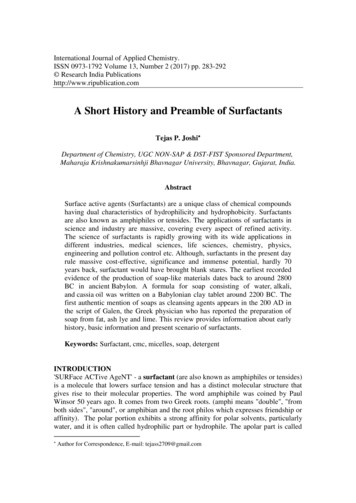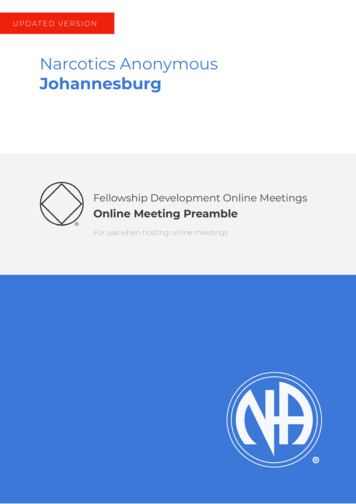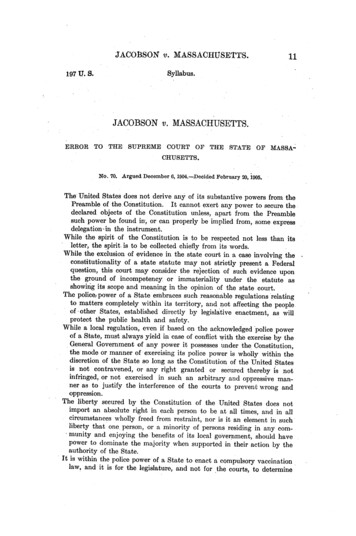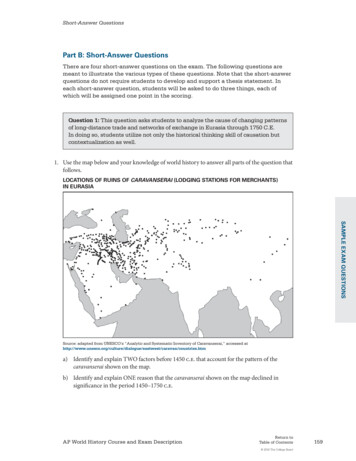
Transcription
International Journal of Applied Chemistry.ISSN 0973-1792 Volume 13, Number 2 (2017) pp. 283-292 Research India Publicationshttp://www.ripublication.comA Short History and Preamble of SurfactantsTejas P. Joshi Department of Chemistry, UGC NON-SAP & DST-FIST Sponsored Department,Maharaja Krishnakumarsinhji Bhavnagar University, Bhavnagar, Gujarat, India.AbstractSurface active agents (Surfactants) are a unique class of chemical compoundshaving dual characteristics of hydrophilicity and hydrophobicity. Surfactantsare also known as amphiphiles or tensides. The applications of surfactants inscience and industry are massive, covering every aspect of refined activity.The science of surfactants is rapidly growing with its wide applications indifferent industries, medical sciences, life sciences, chemistry, physics,engineering and pollution control etc. Although, surfactants in the present dayrule massive cost-effective, significance and immense potential, hardly 70years back, surfactant would have brought blank stares. The earliest recordedevidence of the production of soap-like materials dates back to around 2800BC in ancient Babylon. A formula for soap consisting of water, alkali,and cassia oil was written on a Babylonian clay tablet around 2200 BC. Thefirst authentic mention of soaps as cleansing agents appears in the 200 AD inthe script of Galen, the Greek physician who has reported the preparation ofsoap from fat, ash lye and lime. This review provides information about earlyhistory, basic information and present scenario of surfactants.Keywords: Surfactant, cmc, micelles, soap, detergentINTRODUCTION'SURFace ACTive AgeNT' - a surfactant (are also known as amphiphiles or tensides)is a molecule that lowers surface tension and has a distinct molecular structure thatgives rise to their molecular properties. The word amphiphile was coined by PaulWinsor 50 years ago. It comes from two Greek roots. (amphi means "double", "fromboth sides", "around", or amphibian and the root philos which expresses friendship oraffinity). The polar portion exhibits a strong affinity for polar solvents, particularlywater, and it is often called hydrophilic part or hydrophile. The apolar part is called Author for Correspondence, E-mail: tejass2709@gmail.com
284Tejas P. Joshihydrophobe or lipophile, from Greek roots phobos (fear) and lipos (grease) [Figure 1].In other languages such as French, German or Spanish the word "surfactant" does notexist, and the actual term used to describe these substances is based on their propertiesto lower the surface or interface tension, e.g. tensioactif (French), tenside (German),tensioactivo (Spanish). This would imply that surface activity is strictly equivalent totension lowering, which is not absolutely general, although it is true in many cases.Surfactants exhibit other properties than tension lowering and this is why they areoften labeled according to their main use such as: soap, detergent, wetting agent,dispersion, emulsifier, foaming agent, bactericide, corrosion inhibitor, antistatic agent,etc. [1-5]Hydrophilic group(Polar “head”)Hydrophobic group(Nonpolar “tail”)Figure 1: Representation of a Surfactant MoleculeClassification of surfactantsThe most accepted and scientifically sound classification of surfactants is based ontheir dissociation in water. Surfactants are said to be classify into four broadcategories: anionic, cationic, amphoteric and nonionic. [Figure 2]Figure 2: Representation of different type of surfactant molecules
A Short History and Preamble of Surfactants285Anionic Surfactants give rise to a negatively charged surfactant ion (hence anionic)and a positively charged counter ion upon dissolution in water. Examples of anionicsurfactant groups include sulfonic acid salts, alcohol sulfates, alkyl benzenesulfonates, phosphoric acid esters, and carboxylic acid salts. Anionic surfactantsaccount for about 50% of the world production.Cationic Surfactants yield a positively charged surfactant ion (hence cationic) and anegatively charged counter ion upon dissolution in water. Cationic surfactants firstbecame important when the commercial potential of their bacteriostatic properties wasrecognized by Domagk in 1935. These surfactants are in general more expensive thananionics, because of the high pressure hydrogenation reaction to be carried out duringtheir synthesis.Amphoteric or Zwitterionic When a single surfactant molecule exhibit both anionicand cationic dissociations it is called amphoteric or zwitterionic. This is the case ofsynthetic products like betaines or sulfobetaines and natural substances such asaminoacids and phospholipids.Nonionic Surfactants are characterized by hydrophilic head groups that do not ionizeappreciably in water. Examples include polyoxyethylenated alkyl phenols, alcoholethoxylates, alkylphenol ethoxylates, and alkanolamides. Nonionic surfactants comeas a close second with about 45% of the overall industrial productionAPPLICATIONS OF SURFACTANTSSurfactants play vital role as cleaning, wetting, dispersing, emulsifying, and antifoaming agents in many practical applications and products, including detergents,fabric softeners, emulsions, paints, adhesives, inks, anti-fogs, ski waxes, snowboardwax, herbicides, insecticides, cosmetics, firefighting, pipelines, leak detectors etc.HISTORICAL ASPECTSThe earliest recorded evidence of the production of soap-like materials dates back toaround 2800 BC in ancient Babylon.[6] A formula for soap consisting of water, alkali,and cassia oil was written on a Babylonian clay tablet around 2200 BC. The Eberspapyrus (Egypt, 1550 BC) indicates the ancient Egyptians bathed regularly andcombined animal and vegetable oils with alkaline salts to create a soap-like substance.In the reign of Nabonidus (556–539 BC), a recipe for soap consisted of uhulu [ashes],cypress [oil] and sesame [seed oil] "for washing the stones for the servant girls". [7]The word sapo, Latin for soap, first appears in Pliny the Elder's Historia Naturalis,which discusses the manufacture of soap from tallow and ashes. [8] Soap is mentionedtwice in the Bible, but it is generally agreed that the Hebrew word “borith”, which hasbeen translated as soap, is a generic term for any cleansing agent. According toRoman legend, soap was named after Mount Sapo, an ancient site of animalsacrifices. After an animal sacrifice, rain would wash the animal fat and ash thatcollected under the ceremonial altars down the slopes to the banks of the Tiber River.Women washing clothes in the river noticed that if they washed their clothes in
286Tejas P. Joshicertain parts of the river after a heavy rain their clothes were much cleaner.The Latin word sapo simply means "soap"; it was likely borrowed from an earlyGermanic language and iscognate with Latin sebum, "tallow", which appears in Plinythe Elder's account.[9] Thus the emergence of the first soap or at least the first use ofsoap. Zosimos of Panopolis, circa 300 AD, describes soap and soapmaking.[10] Galen describes soap-making using lye and prescribes washing to carryaway impurities from the body and clothes. Alkali metal soaps (predecessors ofsurfactants) were in use for several thousand years. The first authentic mention ofsoaps as cleansing agents appears in the 200 AD in the script of Galen, the Greekphysician who has reported the preparation of soap from fat, ash lye and lime.According to Galen, the best soaps were Germanic, and soaps from Gaul were secondbest. [10]Soap, or may be called as detergent similar to soap, was manufactured in ancientChina from vegetation and herbs.[11] True soap, made of animal fat, did not appear inChina until the modern era.[12] Soap-like detergents were not as popular as ointmentsand creams. In the eighth century, soap-making was well known in Italy andSpain.[13] The lands of Medieval Spain were a leading soap-maker by 800, and soapmaking began in the Kingdom of England about 1200.[14] A 12th century Islamicdocument describes the process of soap production.[15] It mentions the keyingredient, alkali, which later becomes crucial to modern chemistry, derived from alqaly or "ashes". By the 13th century, the manufacture of soap in the Islamic world hadbecome virtually industrialized, with sources in Nablus, Fes, Damascus,and Aleppo.[16, 17]Near around 15th century, France started semi-industrialized professional for themanufacture of soap in few centers which supplied to the rest of France.[18] Englishmanufacture tended to concentrate in London. Finer soaps were later produced inEurope from the 16th century, using vegetable oils (olive oil) as opposed to animalfats. In 1633 King Charles-I granted a 14 year monopoly to the society of soapmakers of Westminster. Many of these soaps are still produced. Castile soap is apopular example of the vegetable-only soaps derived from the oldest “white soap” ofItaly. In the reign of Elizabeth-I, soap consumption in England was greater than in anyother European country.In 1791, the French chemist Nicolas Leblanc discovered how to extract soda fromcommon salt. In modern times, the use of soap has become universal in industrializednations due to a better understanding of the role of hygiene in reducing the populationsize of pathogenic microorganisms. Industrially manufactured bar soaps first becameavailable in the late 18th century, as advertising campaigns in Europe and the UnitedStates promoted popular awareness of the relationship between cleanliness andhealth.[19] Until the Industrial Revolution, soap-making was conducted on a smallscale and the product was rough. In 1780 James Keir established a chemical worksat Tipton, for the manufacture of alkali from the sulfates of potash and soda, to whichhe afterwards added a soap manufactory. The method of extraction proceeded on adiscovery of Keir's. Andrew Pears started making a high-quality, transparent soap in
A Short History and Preamble of Surfactants2871807 in London. His son-in-law, Thomas J. Barratt, opened a factory in Isleworth in1862. William Gossage produced low-priced, good-quality soap from the1850s. Robert Spear Hudson began manufacturing a soap powder in 1837, initially bygrinding the soap with a mortar and pestle. American manufacturer Benjamin T.Babbitt introduced marketing innovations that included sale of bar soap anddistribution of product samples. William Hesketh Leverand his brother, James, boughta small soap works in Warrington in 1886 and founded what is still one of the largestsoap businesses, formerly called Lever Brothers and now called Unilever. These soapbusinesses were among the first to employ large-scale advertising campaigns.Liquid soap was not invented until the nineteenth century; in 1865, WilliamShepphard patented a liquid version of soap. William Lever and his brothers enteredthe soap business in 1885 by buying a small soap works in Warrington, UK. Usingglycerin and vegetable oils such as palm oil, rather than tallow, to manufacture soap,they produced a good, free-lathering soap, called “Sunlight Soap" [Figure 3]. In 1898,B.J. Johnson developed a soap (made of palm and olive oils); his company (the B.J.Johnson Soap Company) introduced "Palmolive" brand soap that same year. This newbrand of the new kind of soap became popular rapidly, and to such a degree that B.J.Johnson Soap Company changed its name to Palmolive. At the turn of the twentiethcentury, Palmolive was the world's best-selling soap.[20] In the early 1900s, othercompanies began to develop their own liquid soaps. Such products as PineSol and Tide appeared on the market, making the process of cleaning things otherthan skin (e.g., clothing, floors, and bathrooms) much easier. As a detergent, liquidsoap tends to be more effective than flake soap, and tends to leave fewer residues onskin, clothes, and surfaces (e.g., wash basins). Liquid soap also works better for moretraditional/non-machine washing methods, such as using a washboard.[21]Larger premises were built on marshes at what became “Port Sunlight". By 1900“Lifebuoy", “Lux" and “Vim" [Figure 4] brands had been added and subsidiaries hadbeen set up in the United States, Switzerland, Canada, Australia, Germany andelsewhere. Lever Brothers Ltd also acquired other soap companies including A&FPears, Crosfield's of Warrington, Hudson’s of Liverpool. The picture of Lifebuoyfactory which was established in Sydney during 1916 is shown infigure 5.MONKEY BRAND was the popular brand soap of Lever Brothers PVT. Ltd. and wasfirst made in 1902. They used bright colours and the hard, glossy enamel finish meantthat they defied the worst of outdoor conditions for many years. Lever rode thecresting late-Victorian consumer revolution to build a vast industrial empire spreadacross the globe [22].
288Tejas P. JoshiFigure 3: Various packaging of soap called Sunlight soapFigure 4: Packaging of soap called LifebuoyFigure 5: Lifebuoy soap factory
A Short History and Preamble of Surfactants289Figure 6: Lever Bother factory at Balmain during 1928Focus given to artists view towards infrastructure of factories and one of the bestduring those days was the factory of Lever Brother at Balmain [Figure 6]. The picture[Figure 7] is was of chemical laboratory setup used by Lever Brothers, Balmain. AfterWilliam Lever's death in 1925 his enterprises were amalgamated as Unilever. Anotherwonderful factory was established during 1966 by Colgate-Palmolive factory inBalmain [Figure 8].Figure 7: Laboratory of Lever Brothers Balmain
290Tejas P. JoshiFigure 8: Colgate-Palmolive factory, Balmain during 1966During those days, women plead for soap in Sydney due to shortage of laundry soapin Sydney. Toilet soap was becoming scarce too. Film stars were used extensivelyworldwide to promote Lux as shown in figure 9.Figure 9: Lux soap promoted by film star
A Short History and Preamble of Surfactants291Surfactant industries are growing very fast due to its wide application, newformulation and discoveries. Some of the very famous brand of surfactants are Kit,Omo, Surf, Jif, Breeze, Comfort, Huggie, Handy Andy, hair grooming (Vaselinepetroleum jelly), dish-wash (Vim), transparent soap, baby powder, hair lotion (Pears),liquid soaps (Persil), Sunsilk, Oral care (Rexona strip tooth paste), detergent bar(Rin), hair colourant (Harmony), foam bath (Sunja), toilet cleaner (Domestos), floorcleaner or polish (Dual), baby soap (Softly), talcum powder (Rexona), Stick and rollon deodorants (Rexona), Shaving stick (Rexona), etc [22].Recent developments in the field of surfactant include silicone surfactants,fluorocarbon surfactants, gemini surfactants, nonionic types of surfactants havingbranched chain fatty acid alcohol, fatty amines etc. Eco-friendliness is desired portionof surfactant formulations whether if a purpose of uses is either domestic or industrial.Increasing authority pressure for going towards biodegradable products in theindustrial sector is contributing to the increasing in making of specialty surfactants.CONCLUSIONSurfactants specially bio-surfactants are one among those surfactants which arebiodegradable and unharmed surfactants showing more attention due to its diversity,environment friendliness, possibility of their production through fermentation andtheir potential applications in the environmental protection, crude oil recovery, healthcare and food processing industries. One can say that future of surfactant science isvery bright and one can notice tremendous discoveries in near future.ACKNOWLEDGEMENTAuthor acknowledges Head of the Department, M. K. Bhavnagar University for moralboosting and support provided during research work.REFERENCES[1][2][3][4][5][6]A. M. Schwartz, J. W. Perry, Surface Active Agents; their Chemists,Technology, R.E. Krieger, New York, (1978).M. J. Rosen, Surfactants and Interfacial Phenomena, Wiley, New York(1978).Th. F.Tadros, (Ed.), Surfactants, Academic, New York (1984)D. N. Rubingh, P. M. Holland, (Eds), Cationic Surfactants, PhysicalChemistry, Dekker, New York, (1987).SCHWARTZ A.M., PERRY J.W., y BERCH J., "Surface Active Agents andDetergents Volume II" R. Krieger Pub. Co., New York (1977). Réimpressionde l'edition de Interscience de l'année 1958 avec quelques anexes.Willcox, Michael (2000); "Soap". In Hilda Butler. Poucher's Perfumes,Cosmetics and Soaps (10th ed.); Dordrecht: Kluwer Academic Publishers.p. 453.
9][20][21][22]Tejas P. JoshiNoted in Martin Levey (1958). "Gypsum, salt and soda in ancientMesopotamian chemical technology". Isis 49 (3): 336–342 (341).Pliny the Elder, Natural History, XXVIII.191. See also Martial,Epigrammata,VIII, 33, 20.Soap. Etymonline.com. Retrieved on 2011-11-20.Partington, James Riddick; Bert S Hall (1999). A History of Greek Fire andGun Powder. JHU Press. p. 307.Geoffrey Jones (25 February 2010). "Cleanliness and Civilization". BeautyImagined: A History of the Global Beauty Industry. Oxford University Press.Charles Benn (2002). Everyday Life in the Tang Dynasty. Oxford UniversityPress. p. 116.Anionic and Related Lime Soap Dispersants, Raymond G. Bistline, Jr.,in Anionic surfactants: organic chemistry, Helmut Stache, ed., Volume 56 ofSurfactant science series, CRC Press, 1996, chapter 11, p. 632http://www.soap-flakes.com/history.htmlBBC Science and Islam Part 2, Jim Al-Khalili. BBC Productions. Accessed30 January 2012.Michael Phillips (March 11, 2008). "Nablus' olive oil soap: a Palestiniantradition lives on". Institute for Middle East Understanding (IMEU).Retrieved 2008-03-27."Craft Traditions of Palestine"; Sunbula. Archived from the original onMarch 21, 2008.John U. Nef (1936). "A Comparison of Industrial Growth in France andEngland from 1540 to 1640: III". The Journal of Political Economy 44 (5):643–666 (660ff.)McNeil, Ian (1990). An Encyclopaedia of the history of technology. Taylor &Francis. pp. 2003–205."Colgate-Palmolive Company History: Creating Bright Smiles for 200Years". Colgate-Palmolive Company. Retrieved 17 October 2012."The History of Liquid Soap". Blue Aspen Originals. Retrieved sentation-sm.pdf.
In the eighth century, soap-making was well known in Italy and Spain.[13] The lands of Medieval Spain were a leading soap-maker by 800, and soap-making began in the thKingdom of England about 1200.[14] A 12 century Islamic . soap-making was conducted on a small scale and the product w











